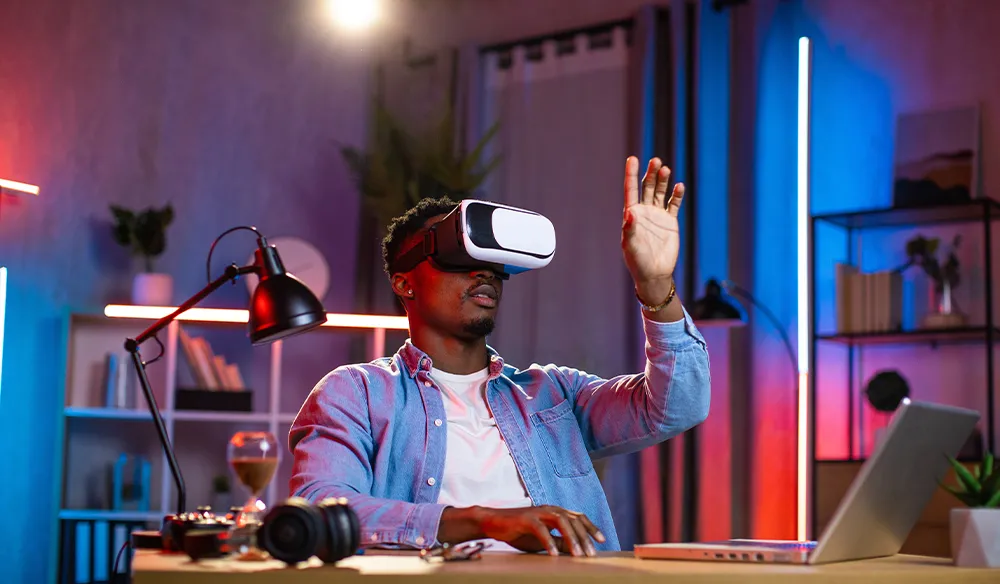Virtual Reality (VR) is no longer a niche technology; it’s rapidly evolving into a powerful medium that’s redefining how we interact with digital content. From breathtaking gaming experiences to innovative training simulations and new ways to connect, VR headsets are opening portals to entirely new digital worlds. If you’ve ever wondered what it’s like to step inside a game, explore a distant planet, or even perform a virtual surgery, VR is your answer.
How Do VR Headsets Work? The Magic Behind the Immersion
At its core, a VR headset creates the illusion of being in a virtual environment. Here’s a simplified look at how it achieves this:
- Stereoscopic Displays: Instead of a single screen, VR headsets have two displays (or a single screen split in two), one for each eye. Each eye receives a slightly different image, mimicking how our eyes naturally perceive depth in the real world. This creates the 3D effect.
- Lenses: Lenses within the headset magnify these images and distort them in a way that, when viewed by your eyes, creates a wide field of view, making you feel like the virtual world surrounds you. They also help focus the close-up screens for comfortable viewing.
- Head Tracking: This is crucial for immersion. VR headsets are equipped with sensors (like accelerometers, gyroscopes, and often external cameras or “inside-out” tracking cameras on the headset itself) that continuously monitor your head movements. As you turn your head, the virtual environment updates in real-time, making you feel as if you are truly looking around within that digital space.
- Spatial Audio: Many headsets include built-in headphones or provide spatial audio capabilities. This means sounds appear to come from specific directions and distances within the virtual world, further enhancing the sense of presence.
- Input Devices (Controllers): Handheld controllers, often tracked in 3D space, allow you to interact with the virtual environment – grabbing objects, firing weapons, navigating menus, and more, making interactions feel natural.
Beyond Gaming: The Expanding Universe of VR Applications
While gaming has been a primary driver of VR’s popularity, its applications are rapidly expanding into diverse fields:
- Education & Training: Imagine exploring ancient Rome, dissecting the human body in a virtual lab, or practicing complex surgical procedures without risk. VR offers immersive and interactive learning experiences for students and professionals alike, from medical training to flight simulations and emergency response drills.
- Healthcare: VR is being used for pain management (distracting patients during uncomfortable procedures), therapy for phobias and PTSD (controlled exposure therapy), physical rehabilitation, and even mental health support, by creating calming virtual environments.
- Architecture & Design: Architects can walk clients through virtual models of buildings before construction begins, allowing for early identification of design flaws and better visualization.
- Real Estate & Tourism: Virtual tours allow prospective buyers to explore properties from anywhere in the world. Similarly, you can “visit” famous landmarks or exotic destinations without leaving your home.
- Social & Collaboration: Social VR platforms allow people to connect in shared virtual spaces, fostering a sense of presence even when physically separated. This is extending to virtual meetings and collaborative workspaces.
- Fitness & Wellness: VR fitness apps turn workouts into engaging, gamified experiences, making exercise fun and motivating. From boxing in virtual arenas to cycling through futuristic landscapes, VR is transforming how we stay active.
The Future of VR Headsets: Immersive & Intuitive
The VR landscape is constantly evolving, with key trends shaping its future:
- Wireless Freedom: The move towards standalone, wireless headsets (like the Meta Quest series) continues, offering unparalleled freedom of movement without being tethered to a PC.
- Higher Resolution & Wider Field of View: Displays are becoming sharper, reducing the “screen-door effect” and creating more photorealistic graphics, making virtual worlds feel even more lifelike.
- Mixed Reality (MR) Capabilities: Many new headsets integrate cameras that allow you to see your real surroundings while also overlaying virtual objects. This “passthrough” technology blurs the lines between the physical and digital worlds, opening up new possibilities for gaming, productivity, and interaction.
- Eye Tracking & Haptic Feedback: Eye tracking allows for more natural navigation and foveated rendering (optimizing graphics where you’re looking), while advanced haptic feedback adds realistic touch and texture to virtual objects, making interactions feel more real.
- Lighter & More Comfortable Designs: Manufacturers are focusing on reducing weight and improving weight distribution for extended wear, making VR experiences more comfortable.
The world of Virtual Reality is expanding at an incredible pace, offering experiences that were once the stuff of science fiction. Whether you’re a gamer looking for ultimate immersion, a professional seeking innovative training tools, or simply curious about exploring new digital frontiers, there’s a VR headset for you.
At Electronics Place, we bring you closer to these new digital worlds. Explore our selection of cutting-edge VR headsets and accessories, and step into the future of immersive technology today!





 No products in the cart.
No products in the cart.